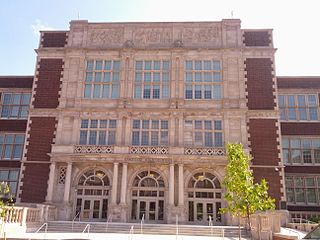
Gary is a city in Lake County, Indiana, United States. The city has been historically dominated by major industrial activity and is home to U.S. Steel's Gary Works, the largest steel mill complex in North America. Gary is located along the southern shore of Lake Michigan about 25 miles (40 km) southeast of downtown Chicago, Illinois. The city is adjacent to the Indiana Dunes National Park, and is within the Chicago metropolitan area.

Park Ridge is a city in Cook County, Illinois, United States, and a Chicago suburb. Per the 2020 census, the population was 39,656. It is located 15 miles (24 km) northwest of downtown Chicago. It is close to O'Hare International Airport, major expressways, and rail transportation. It is a part of the Chicago metropolitan area, bordering three official neighborhoods on Chicago's Far Northwest Side

Hammond is a city in Lake County, Indiana, United States. It is part of the Chicago metropolitan area, and the only city in Indiana to border Chicago. First settled in the mid-19th century, it is one of the oldest cities of northern Lake County. As of the 2020 United States census, it is also the largest in population. The 2020 population was 77,879, replacing Gary as the most populous city in Lake County. From north to south, Hammond runs from Lake Michigan down to the Little Calumet River; from east to west along its southern border, it runs from the Illinois state line to Cline Avenue. The city is traversed by numerous railroads and expressways, including the South Shore Line, Borman Expressway, and Indiana Toll Road. Notable local landmarks include the parkland around Wolf Lake and the Horseshoe Hammond riverboat casino. Part of the Rust Belt, Hammond has been industrial almost from its inception, but is also home to a Purdue University campus and numerous historic districts that showcase the residential and commercial architecture of the early 20th century.

Cardozo Education Campus, formerly Cardozo Senior High School and Central High School, is a combined middle and high school at 13th and Clifton Street in northwest Washington, D.C., United States, in the Columbia Heights neighborhood. Cardozo is operated by District of Columbia Public Schools. The school is named after clergyman, politician, and educator Francis Lewis Cardozo.

Theodore Roosevelt High School, often referred to as Kent Roosevelt (KRHS), is a public high school in Kent, Ohio, United States. It is the only high school in Kent and the Kent City School District and serves students in grades 9–12 living in Kent, Franklin Township, Brady Lake, and Sugar Bush Knolls as well as a small portion of southern Streetsboro. As of the 2021–22 academic year, enrollment was 1,267 students with 73 teachers for a student–teacher ratio of 17:1. Recognition for academic performance over the years has come from the United States Department of Education, Ohio Department of Education, and U.S. News & World Report.

Theodore Roosevelt High School, originally Roosevelt High School, the third public high school to open in the Bronx, New York, operated from 1918 until its permanent closure in 2006. Shutting down incrementally since 2002, this large high school, initially enrolling about 4 000 students, yearly dwindled, newly sharing its 1928 building with new, small public high schools—all pooling students for major, extracurricular activities like athletics and JROTC—a reorganization renaming the building Theodore Roosevelt Educational Campus, still open after the historic, namesake high school ceased in 2006. At its November 1918 opening, Roosevelt High School operated in the building of school PS 31.
The Westfield Public Schools is a comprehensive community public school district that serves students in pre-kindergarten through twelfth grade from Westfield, in Union County, New Jersey, United States.

Crispus Attucks High School is a public high school of Indianapolis Public Schools in Indianapolis, Indiana, U.S. Its namesake, Crispus Attucks, was an African American patriot killed during the Boston Massacre. The school was built northwest of downtown Indianapolis near Indiana Avenue and opened on September 12, 1927, when it was the only public high school in the city designated specifically for African Americans.

Roosevelt High School (RHS) is a public secondary school located in the Roosevelt neighborhood of Seattle, Washington, United States. Opened in 1922 to relieve overcrowding at Lincoln High School, it ranks as the second-largest high school in Seattle Public Schools. NPR described RHS as "an above-average school in a below-average school district" based on test scores in 2001.
Martin Luther King High School is a neighborhood public high school located in the East Germantown section of Philadelphia, Pennsylvania. It is located at the intersection of Stenton Avenue and Haines Street in Philadelphia. It is a neighborhood school, meaning no application is necessary for those students who live in the West Oak Lane and Germantown sections of Philadelphia. It is named after Martin Luther King Jr.

Gary Community School Corporation serves most students who reside in Gary, Indiana.

Southlake Mall is a shopping mall in Hobart, Indiana that is marketed as being in Merrillville, Indiana, due primarily to being served by the 46410 postal Zip Code. The tract of land on which it sits was annexed by the city of Hobart from unincorporated Ross Township in 1993. It lies in the Chicago metropolitan area. Southlake Mall is the only enclosed super regional mall in Northwest Indiana, as well as one of largest in the state overall along with Castleton Square in Indianapolis and Glenbrook Square in Fort Wayne. The mall's anchor stores are Kohl's, JCPenney, Macy's, H&M, and Forever 21. There are three vacant anchors stores that were once Dick's Sporting Goods, Carson Pirie Scott, and Sears. The Macy's store was an L. S. Ayres store prior to September 9, 2006. The mall first opened with only two anchor stores – JCPenney and Sears – and the north and south anchor wings were added later. The former Carson's had housed the cafeteria-style "The Garden Restaurant" by the entrance near the security garage on the south side of the mall from 1975 to 1989.

William Butts Ittner was an American architect in St. Louis, Missouri. He designed over 430 school buildings in Missouri and other areas, was president of the St. Louis Chapter of the American Institute of Architects from 1893 to 1895, was awarded an honorary degree by the University of Missouri in 1930, served as president of the Architectural League of America during 1903–04, and at the time of his death was president of the St. Louis Plaza Commission, a fellow and life member of the American Institute of Architects, and a thirty-third degree Mason. He was described as the most influential man in school architecture in the United States and has a star on the St. Louis Walk of Fame. He was appointed St. Louis School Board commissioner in 1897 and is said to have designed open buildings that featured "natural lighting, inviting exteriors, and classrooms tailored to specific needs." In 1936, Ittner died. His legacy is survived by the William B. Ittner, Inc. and Ittner & Bowersox, Inc. architecture firms in St. Louis.

Theodore Roosevelt High School is a public high school operated by the District of Columbia Public Schools in the Petworth neighborhood of Ward 4 neighborhood of Northwest Washington, D.C. Roosevelt enrolls 698 students (2017–2018) in ninth through 12th grade. Additionally, the high school is also home to Roosevelt S.T.A.Y. program, an alternative academic and career/technical program that leads to a high school diploma or vocational certificate.
Rockwood Summit High School is a public high school in Fenton, Missouri that is part of the Rockwood School District. Summit opened in 1993 on the same day as Marquette High School, another Rockwood high school.

Emerson, also called Downtown East, is a neighborhood in north-central Gary, Indiana. Emerson and Downtown West combine to form what is known as Downtown Gary. It was part of the original plat built by the United States Steel Corporation. Emerson is located east of Broadway, south of the Grand Calumet River, north of Ninth Avenue and west of Interstate 65. As of 2000, it had a population of 3,358. Emerson borders directly on Downtown West to the west but is separated from the Aetna and Pulaski neighborhoods to the east and south by an industrial corridor.

Emerson High School was a public high school of the Gary Community School Corporation, located in a historic facility in Gary, Indiana, United States.
Roosevelt Junior College was an institution serving African-American students, located on an 18-acre campus at 1235 Fifteenth Street in West Palm Beach, Florida. It took its name from the adjacent black Roosevelt High School, named in honor of former U.S. President Theodore Roosevelt.
Calumet is the portion of East Chicago, Indiana located east of the Indiana Harbor and Ship Canal and south of Chicago Avenue. The neighborhood is bisected by the Indiana Harbor Belt Railroad. The area west of the tracks is referred to as Calumet proper, or as "West Calumet". The area east of the tracks is known as "East Calumet."

Cheryl Pruitt is an American educator and advocate for alternative education. She was Superintendent of the Gary Community School Corporation from 2012 to 2018, and she has served in executive roles for several other organizations that seek to improve inequalities in traditional public education settings.





















